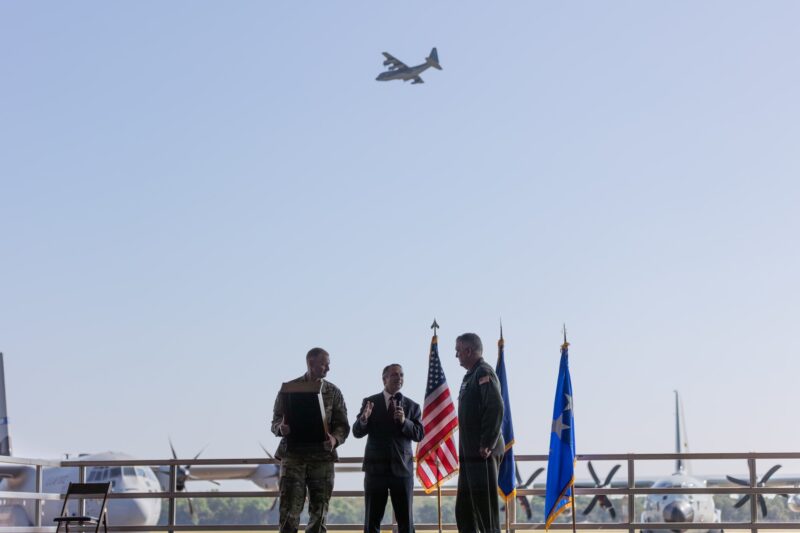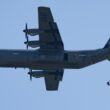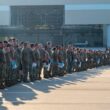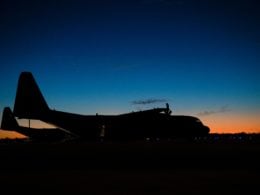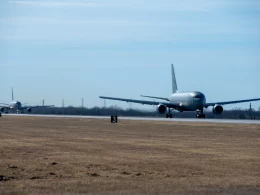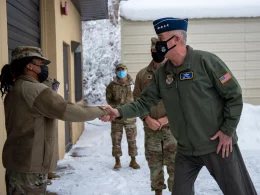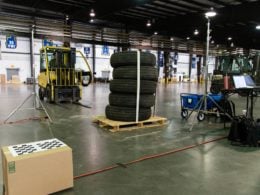ROBINS AIR FORCE BASE, Ga. —
Members of the C-130 Hercules community, past and present, from Air Mobility Command, Air Force Materiel Command and Lockheed Martin gathered at Robins Air Force Base, Georgia, Aug. 23, 2024, to celebrate the 70th anniversary of the 1954 YC-130’s first flight.
The Herk, or Herc, (an endearing nickname for the C-130 Hercules), is the present-day variation of the YC-130 and has served in multitude of roles, and its influence and legacy has been widespread throughout its time with the Air Force. From proving the importance of intra-theater airlift during the Korean War to the Vietnam War’s reliance on the C-130 for troop carrier missions and rugged operating capabilities, the versatile aircraft continues to stand the test of time.
Predecessors to the C-130 were often derived from either bomber or commercial aircraft such as the C-47 Skytrain or C-119 Flying Boxcar, posing significant challenges in many key areas of the airlift mission. These solutions worked for World War II, but as the Army and Air Force’s requirements evolved post-war, the need for a “workhorse” aircraft emerged.
“There is almost no mission-set that [the C-130] doesn’t touch in one way or another,” said Michael Beasley, Senior Materiel Leader for the C-130 Division, Air Force Lifecycle Management Center. “Every aircraft has a role and a niche that the other ones can’t fill. The last tactical mile is how you get things from a staging point and into theater; that is where the C-130 thrives.”
The Hercules is a continually evolving multifunction aircraft, earmarked by its flexibility and versatility. In 1957, just three years from its initial flight, a ski-equipped modified C-130A model was being tested by the Air Force. Today, different variants of the plane can be equipped with turrets for combat or radar for weather reconnaissance.
According to Capt. Jake Miller, a C-130 pilot with the Georgia Air National Guard, flexibility is what makes the aircraft special.
“There is stuff you can learn from each of the different models,” said Miller. “The newer ones are advanced, and you get good at that and using all your tools—but there is still going to be times when you have to rely on your own, manual flight experience.”
Over the past seven decades, this flexibility and evolution the C-130 has seen is largely due to command relationships within the Air Force. According to Beasley, coordination between the requirements, sustainment, and operator communities at AMC and AFMC allows the AFLCMC to focus on sustaining current models and developing requirements for future evolutions.
“With all of the new upgrades and models, [the C-130] is actually pretty advanced now—avionics and navigation-wise—and all of that technology helps us be better with the mission,” Miller said.
Apart from technological advancements the Hercules helped usher in, the Hercules also left a cultural footprint on the Mobility Air Forces.
“That airplane is a monument to everybody who fly fixes and supports it, and it brings out the best of our people, the best of our service and the best of our country,” said Gen. Mike Minihan, Air Mobility Command commander and C-130 pilot, during his keynote address at the 70th anniversary celebration. “No matter who’s flying it, if there’s a C-130 on the ramp, it could be another service or another country, you automatically walk down there and make friends”
Minihan further detailed in his letter, To the C-130, With Love, the grueling blue-collar culture of being a C-130 pilot, expending blood sweat and tears as an American, Airman and warrior. He, along with other members of Herk Nation, executed the mission together.
“It doesn’t matter whether you’re wearing a flight suit, camouflage, a business tie, or whatever you’re wearing—you are a part of Herk family,” Beasley said.




